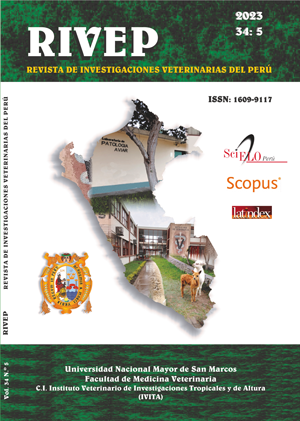Effect of chicken blood and intestines silages, as partial substitutes for fishmeal, on the growth of tilapia fingerlings (Oreochromis niloticus, Linnaeus, 1758)
DOI:
https://doi.org/10.15381/rivep.v34i5.24624Keywords:
tilapia feed, biological silage, chicken intestines, chicken blood, costsAbstract
The inclusion of biological silage from chicken intestines and blood in the feed for Nilotic tilapia Oreochromis niloticus, substituting 80% of the protein content of fishmeal, was evaluated. The silages were made with 70% waste, 15% energy source (14% molasses and 1% sugar) and 15% yogurt (lactic acid bacteria). The pH and acidity were determined for 180 days, and the chemical analysis was done using standard methods. The base diet was formulated with the minimum cost equation, and considering the nutritional requirements for tilapia, inclusion levels and cost of inputs. A control diet and two with silages were used. The fingerlings (n=270) with an initial weight of 5.17 ± 0.18 g were randomly distributed in nine aquariums (3 per diet). The fish were fed three times a day and evaluated monthly. A significant difference (p<0.05) was found in the final weight and biomass averages between the control and silage. Feed conversion factor (FCA) and protein efficiency ratio (PER) were similar between diets (p>0.05). The cost to produce 1 kg of tilapia was lower in the diet with intestine silage (USD 1.16), followed by blood silage (USD 1.20), meaning a reduction in feeding costs of 29.26 and 26.48%, respectively.
Downloads
Downloads
Published
Issue
Section
License
Copyright (c) 2023 Catalina Díaz-Cachay, Betty Gamero-Collado, Claudio Alvarez-Verde, Carlos Llontop-Vélez, Abel Walter Zambrano-Cabanillas

This work is licensed under a Creative Commons Attribution 4.0 International License.
AUTHORS RETAIN THEIR RIGHTS:
a. Authors retain their trade mark rights and patent, and also on any process or procedure described in the article.
b. Authors retain their right to share, copy, distribute, perform and publicly communicate their article (eg, to place their article in an institutional repository or publish it in a book), with an acknowledgment of its initial publication in the Revista de Investigaciones Veterinarias del Perú (RIVEP).
c. Authors retain theirs right to make a subsequent publication of their work, to use the article or any part thereof (eg a compilation of his papers, lecture notes, thesis, or a book), always indicating the source of publication (the originator of the work, journal, volume, number and date).










